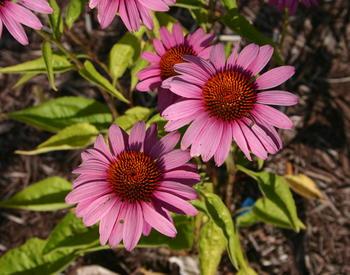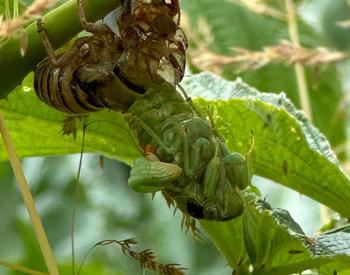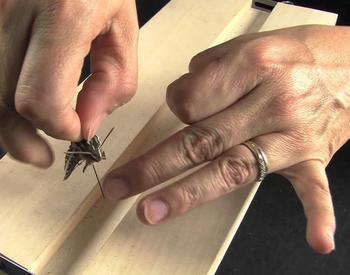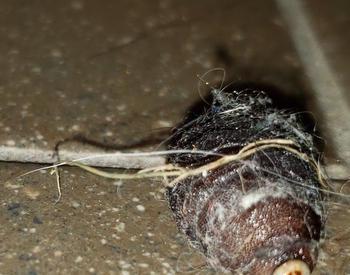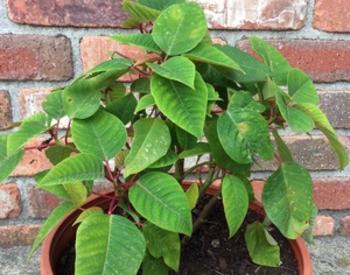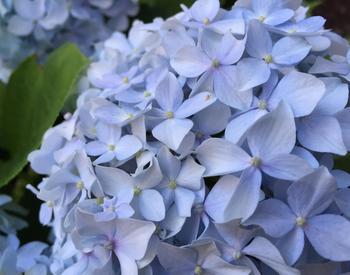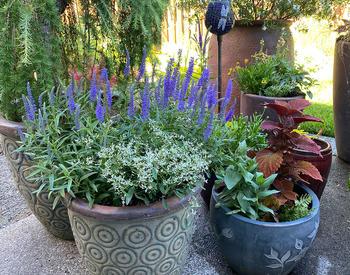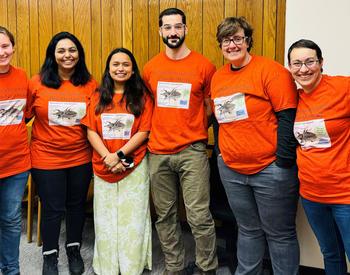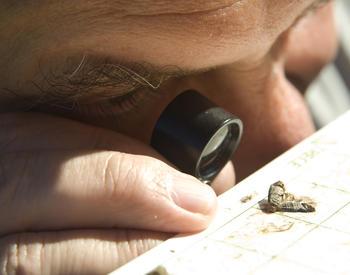Transcript
Speaker 1: From the Oregon State University Extension Service, this is Pollination, a podcast that tells the stories of researchers, land managers, and concerned citizens making bold strides to improve the health of pollinators.
I'm your host, Dr. Adoni Melopoulos, assistant professor in pollinator health in the department of horticulture. How did this happen? It's July already. The spring has already gone by. All those beautiful flowers that we had in our gardens in the spring, they faded and we're into midsummer. And we're also seeing some of our midsummer bees come out. I just saw one of our sunflower bees, one of our sunflower bee species out the other day.
Bumblebees, we're seeing workers, even males. The season has progressed. To help us understand these changes, I've invited on to the show Haley Wallace. Now Haley has her master's degree in environmental science and management at Portland State University. She got that in 2019. Her master's thesis was this really great project looking at gardens in the Portland area and how they change.
It was focused on this effort that I'm sure if you were in the Portland area, you heard about B-Count PDX volunteers being involved in doing these assessments. So Haley's going to tell us a little bit about that this week. Haley is also one of our two transcribers on the podcast. We now have transcription services. You can follow the transcripts along with Alina Dickerson, who's with the Oregon Bee Atlas.
So check that new feature out on the website. A reminder to fill out our pollination podcast survey. You can see it on our website, pollinationpodcast.oregonstate.edu.
It's right at the top. It'll only take a few minutes and you can win a limited Rare Oregon Bee Project ball cap. I'm also excited to announce our next monthly webinar, Wild World of Bees, is with Olivia Messenger Carroll from The Bees in your backyard. It's going to be this Thursday, July 9th at 7 p.m. Pacific time. Please pre-register.
Just go to your browser and type Wild World of Bees. Find Olivia's event page and just click and then register and we'll see you on Thursday. Hope you enjoy the episode. Hey, Haley, how are you doing? Good, how are you? All right. So I mentioned in the introduction that you're our transcriber. You have been going through and transcribing our shows is a new feature of the show. Tell us a little bit about that. We tell you a bit about transcribing the shows.
Speaker 2: Yeah, so it's great. You know, I have a lot of fun doing it. I myself, when I listen to podcasts, not only listen to the audio but if they have it available, I will actually read text or the transcribed text as well. And so I find it very useful when I'm listening to podcasts to do that.
I feel like it really helps the information sink in. So I was already a listener to the Pollination Podcast. So when, you know, the opportunity became available to transcribe the podcast, you know, I jumped on it. And I think it's a lot of fun. I've had a lot of fun learning about new things related to honeybees because before my knowledge was really just based on native bees. So that's been really exciting for me.
Speaker 1: Oh, yeah, it's true. The show is grateful. For me, it's just the education of it all. I love and I always think when we're recording this and I dropped a little file in that you're going to experience the conversation in a way that maybe other people won't because you're going sort of line by line and making sure everything's correct.
And the other thing you're doing, people who listen to the show know that we've changed or follow us on social media. We have these quotes now. We've got a key quote and you're the one who's going through and sort of like judging and like, this is the crux of the interview.
Speaker 2: Yeah, this is a good quote. It's funny. I keep a Word document as I'm listening to the podcast and at the end, I'll probably have 10 or 15 quotes that like, I'm like, these are amazing. And then I have to shorten it down and just take like two or three. So it's really awesome because I listen to the podcast multiple times while I'm transcribing it. So I feel like it really sinks the information into me. And then I'm like having dinner with my family and I'm like telling them all about Mason bees, even though they like didn't ask. I think it's just kind of always in the back of my mind, which has been really great to learn about new things and, you know, new things to research to like, I can't remember the name, but the episode about the bees and the Air Force and how they were getting it. They were nesting.
Speaker 1: Oh, I know. Wasn't that fascinating?
Speaker 2: I had no idea. And I talked about it with my family for like four days. And I was like, I had no idea the government-funded bee research and all this stuff.
Speaker 1: I don't think people quite realize that sometimes I don't know where the show is going. And I remember when Megan Ash said that, it's like, oh, yeah, it's this legacy project around like, you know, rocket ships. I was like, what?
Speaker 2: Yeah, he's talking about NASA. I had to re-listen to it like four times. Like, did they say NASA? Like, so it's great. Yeah, I love it.
Speaker 1: Well, for those of you who haven't checked recently, we've moved the whole podcast. I think we're going to flip the switch on the old website, the WordPress website. And it's now on the extension website, which is really exciting.
And I had that extra feature for transcription. So check it out. But today I wanted to talk with you. And one of the things I'm fascinated with is the research that you did in your master's thesis. The research you did into changes in both bee and plant communities in Southeast Portland. But just to begin with, can you describe like if you're not from Portland and you walk around in Portland, what's the range of gardens that you'd see in pollinator gardens you'd see in Portland?
Speaker 2: So it's a great question. There's a really large range of gardens and pollinator-type gardens that you would see just walking around Portland. My studies were mainly in Southeast Portland. So in all of Portland, there are a lot of homeowners who are really interested in having what's called a bee-friendly backyard. So they will have these areas of their garden or areas of their lawn that they don't mow or they leave litter out or they plant plants that they think are going to be beneficial for pollinators, either just because they like the bees and want to help the bees or they want the bees to come to pollinate their garden, things like that. Additionally, there are gardens that are created by like Portland Parks and Rec and other nonprofits that kind of combine conservation areas with pollinator gardens. One example is the nonprofit in Southeast Portland, which is called Green Lentz. And they have created multiple pollinator conservation areas for pollinator benefit. One of those being Johnson Creek Commons is a large area that's in the middle of apartment housing, in the middle of an apartment complex. And they have this large area that they planted with all these plants and it's next to their gardens.
And it's great. It's a great thing to be able to combine, you know, water retention and soil retention and all of that stuff and combine it with plants for pollinators. Another thing would be community gardening plots in Portland recently. Yeah.
So that's a really big deal. There's in neighborhoods in Portland, that will have a community garden, such as the Lentz Community Garden or the Frazier Community Garden. And it's these areas where people in the community can come in. They can rent a garden space. They can garden whatever vegetables they want. These areas are also starting to plant little tiny areas for pollinator habitat so they can provide floral resources for the pollinators to be able to come and also pollinate their gardens.
So there's, I would say, a very large range. When I was doing my graduate work about a year ago, it seemed to be everyone jumping on the idea of planting for pollinators, which was really exciting for me. And also it led to a lot of opportunities for me to do my master's thesis work.
Speaker 1: Well, let's get into that. Tell us a little bit about the places. Tell us a little bit about the sites that you did your study on and what were told us a little bit about the plants that were growing in those sites. Yeah.
Speaker 2: So I chose to focus on Southeast Portland because the nonprofit that I mentioned earlier, Green Lentz, I had found that they had planted three different conservation areas that were for water retention, and soil retention, and had meshed them with the idea of planting for pollinators. And two years ago, when you would type into Google, you know, pollinator plant lists, you would come up with a hundred different lists that would list all these different plants. And I found that most of these lists were not actually backed by scientific data. And they were just lists that people, you know, all bees like this, bees like this. And so at that time, my main question was, you know, we're going through all of this work to plant all of these conservation areas for pollinators. But are we actually providing the resources that the pollinators prefer or resources that are, you know, actually used?
So that was the question that I had. And I found out that Green Lentz had these three separate large conservation pollinator areas that they had planted each one with a different pollinator plant list that they had gotten off the internet.
Speaker 1: Goodness, that's great.
Speaker 2: Yeah. So for me as a researcher, I was like, that is amazing. That's such an opportunity to be able to, you know, see what bees are using what plants at these different sites. So there was a large variation of the plants at each site. So one of the sites that I mentioned earlier, Johnson Creek Commons, was right in the smacked out in the middle of, you know, a big apartment complex that they had this large area and it had quite a few plants.
So things like Dogwood, Checker Mallow, Blanket Flower, Penstemon, things like that. I did my monitoring for June, July, and August. So that was in June when I had all those plants. And then interestingly, it shifted into just being comprised of Golden Rod and Fireweed in July and August. And then another site is Byercourt's Rain Garden.
And that was also located in front of a very large apartment complex right next to the road, but it had the highest number of species. Things like Douglas-Aria, Oregon Shun Sunshine, Twin Berry Honey Suckle, and Blanket Flower. And then that actually shifted plant composition to mostly being comprised of Douglas Aster in July and August. And then the last site was what are called bioswales. So Yukon bioswales, which are these areas of soil that are like between where the grass and the sidewalk on the street is, or people's mailboxes usually are.
And they're used for like stormwater retention. And so those were comprised of like knotting onion, California poppy, roast campion, and then those shifted to being comprised of penstemon species towards the end.
Speaker 1: Isn't that fascinating?
Speaker 2: Yeah, I had no idea.
Speaker 1: But it's a great situation because you've got these really different kinds of phenologies in different plant communities within a really close area where you can actually kind of parse these things out. So I imagine the very first question is, how did you assess things?
How did you assess where bees were visiting the different sites and how did you keep track of which bees were going to which flowers? How did you do all that?
Speaker 2: Yeah, so that was definitely the biggest question and the biggest task. And for me personally, I felt that it was really important to involve community members in my master's thesis. You know, I myself got involved in the bee world when I was an undergraduate and I had thought there were only honey bees and bumble bees. I had no idea about the huge world of bees there are. So I really wanted to involve community members and really like open their eyes to say there are these amazing natural things around you that are beautiful that you just don't know about. So I actually created a community science program, which I called B to count P.D . X. Where I trained community members to identify bees.
So I used the Xerxes, Marie Time, and Citizen Science, monitoring protocol. And what that did is split all of the bees that we have in Oregon into 12 morphological groups. So the splits are based on things like physical characteristics. So, you know, scopal hair location, body size, coloration, things like that.
So as you know, it's so hard to identify bees. So breaking it down into these 12 different groups for community members made it a lot more manageable for them to be able to parse and say, you know, what group was that be in?
Speaker 1: And tell us a little bit about that part. What was there? Was it hard for them? Was it challenging? I know people like you say most people start. I can tell a honey bee is a bumble bee. Ron Spendle, we had a bunch of said people say honey bee bumble bee in yellow jackets. Well, I know three species. So how hard was it for them to learn these categories?
Speaker 2: So I would say that it was moderate. I think that just the vast amount of information that was given to them was the most overwhelming because like you said, most people only think that there are those three types of bees. So when I'm telling them, like, no, there are these teeny, tiny black bees and there are these big, shiny green bees, you know, I think the information was more as kind of like an overload to them.
But the ones I was able to show them like, no, like this is how you tell it from the coloration of the band that's on the size, you know, they were able to pick it up relatively quickly. So, for example, tiny dark bees are one of the groups that Xerxes has. And that includes multiple bees. So includes like small sweat bees, small carpenter bees, and yellow-faced bees. Yeah. So they weren't having to really look and see, OK, like, you know, it's T one or T three yellow or
Speaker 1: black, you know, like they were able to see. Small and black. Yeah, a small block is a tiny dark bee. Which was really, which was really great for them. So I actually went out and did field days with my volunteers before we started collecting data to say, OK, this is this bee, this is this bee. And we actually provided them with what are called insect vacuums. I'm not sure if you're familiar with it. It's about 13 inches long and it looks like a water gun. Oh, no, no, I do know these. The late great Robin Forp had these little they were called they were called the bug safari.
Speaker 2: Mm hmm.
Speaker 1: Yeah, yeah, yeah. But the bug safari's got a little two double batteries in it and it goes. And exactly. Oh, you had those. Oh, great.
Speaker 2: Yeah, I did. So I bought those for my community members because I had used them before. And I think they're amazing. So I'll explain to listeners who don't know what it is. It's this water gun-looking contraption that has a little vacuum inside it. So you put the bee vacuum up to a bee, you pull the trigger, the vacuum starts, and it sucks the bee into the vacuum and puts it into like a clear plexiglass chamber, which you can then either disconnect and put like a magnifying not loop, but a magnifying lid on top of it and look at it more closely.
Or you can just hold it up and look at it. And the bee doesn't get hurt. You know, it doesn't stress and doesn't stress it is out that much.
You know, once you are done, you just open it up and the bee just flies away. Oh, that's great. Yeah.
So I was I was able to provide those to my volunteer. So in the beginning, when we would be walking along the transect lines, they would just point their insect vacuum down, suck the bee up, and look at it. And then once we did that for a couple of weeks, they were able to tell just by eye when they're walking like, oh, that's a honey bee. That's a tiny dark bee once they get used to it. That's great.
Speaker 1: OK, that's fantastic. I'm really glad I really love those things. They used to have a bunch of them and I don't know where they are right now, but they are there. They are literally a kid's toy that serious researchers buy in bulk.
Speaker 2: I know I bought them on Amazon and they were in the kids section.
Speaker 1: And I was like, I would have loved one of these as a kid, because you can suck up other insects with them, too, not just bees, but they're great for bees. And also it was a relatively big deal for my community members. They were really worried about getting stung, like they were really, really concerned about it. And so having them use the insect vacuum and say, no, like you can get this close to a native bee, you can suck it up, you can look at it and then let it go. And it's not going to come back and attack you.
Speaker 2: Yeah, I think really gave a lot of people a piece of mind and knowing, like, OK, like I can get really close and look at them and I'm not going to get attacked. So I think that was really helpful for people also.
Speaker 1: What a great, smart way to sort of involve people. That's really great. OK, so you've got you've got them collecting this data with you really engage the community, which I can just imagine has all sorts of side benefits. But tell us about the seasonal patterns of both the bees and the plants from June to August in these different gardens. And it seems like from what you said earlier, the month really mattered.
Speaker 2: Yeah, so the data that we collected, I collected data weekly at my site. And then I asked volunteers to collect data monthly at my site. So over the three months, we observed over 600 bees, which I thought. Yeah, I thought that it was going to be a lot less than that. So I was very, very happy.
And the data we collected, not only did we collect what kind of bee it was, but also what kind of plant, what species of plant did it land on? How sunny was it? What was the cloud cover like?
What you know what I mean? What temperature was it? Was it smoky?
Was it hazy? All that stuff. So wow.
Yeah. So in the end, when I was trying to figure out, you know, what is significant, I was able to do statistics and try to identify, you know, what would predict bee presence. And I found that month was a very significant predictor. So not only in terms of the frequency of bees, but also of what bee groups we were seeing. So as I mentioned earlier, there's a huge shift in floral species richness in my sites from June, July to August. So just to give an example in Johnson Creek Commons in June, there were 16 flowering plants in July. There were six. And in August, there were only three. So this huge shift for the bees from six, having 16 plants available for you to use to only having three plants made a huge difference.
As of course, it went for anything. And so month mattered because of floral resource frequency. So there weren't enough late-season blooming plants at my sites for the bees to use.
But it also mattered for what bee group we saw. So in June, we saw a really high number of bumblebees and striped sweat bees. And then in July, we actually saw our peak numbers and our highest were bumblebees. And then it switched to tiny dark bees, like a group of little bees. And then in August, we saw a really high number of bumblebees. And then a really low number of tiny dark bees.
So in, you know, parsing out my research and, you know, figuring out what this means to me, it meant that in August, because we saw fewer bees than we did the month before, it was really tied with available floral resources. So there weren't enough resources for them. You know, everything was really dry.
Everything was dead. So of course, there's going to be way fewer bees. That also, as a scientist made me question, you know, if we add all these late season plants and we're doing all this, or we saw 600 bees, if you were to add all the stuff, are you going to be seeing, you know, 1200 bees, 2400 bees? You know, so it's a lot of room for improvement and a lot of room for learning.
Speaker 1: I think that's always the sign of a great research project. It's sort of because there is this question. Like, I often wonder this, too. We were up in the we've been doing some work in the mid-Columbia. And there the plant communities really spring.
focused. Everything kind of pops up and then by this time of year it dries the bone. And you think, oh, the bees must be adapted to that. But what happens, you know, it does raise the question, what if you like to push things into the, would, you know, be species that were just not, couldn't make it there, start to immigrate in and really, you know, it becomes a kind of moving Jenga puzzle.
Speaker 2: Exactly. And like, if the resources are there, you know, will they stay? Will there be more bees there? It's really an interesting question to see. Because I before, you know, I thought about in July and August, I'd seen dry shoulder plants, but I've never really thought about how much that would affect bees, you know, going from having 16 plants that you can use, not even plant 16 species that you can use to going to only have three. So it's like you're not maybe not have your preferred plant available to you if you're a bee in August.
Speaker 1: Well, let's take a quick break. We'll come back and want to hear more about some of the bees that we're visiting and also some of your favorite plants. So we'll be back in just a second.
We are back. So, when we took the break, you mentioned that I always wondered what happens in between because you're always transcribing podcasts. You'd never get to hear that in between parts. And now you've finally experienced the in-between.
Speaker 2: It is. It's so interesting. It's like I thought it was going to be, but a little bit different. But I'm really glad you had me on. I appreciate it.
Speaker 1: Well, at the break, we sort of, I wanted to add a question in because we did spend a little bit of time talking about, you know, the decision you made to have citizen science involvement and that you that the one thing that you told me is like, I initially I thought I really wanted to do an experiment from my graduate work where I was going to identify bees to species, but that you really don't regret the decision of using these broader groups to engage people. Tell us a little bit more about that engagement beyond just generating the data.
And then we'll come back to the data. But what is that? What is that like? And what is what? Tell us a little bit about what you, how you thought about that. Yeah.
Speaker 2: So, you know, I went into my graduate work at Portland State really having a gung-ho idea about, you know, I'm going to identify all these bees to species. I'm going to do bull traps or pan traps. And then I decided that it was really important to involve community members because I feel personally like there's this big gap between the scientific community and the regular community. And I feel like there really doesn't need to be this large gap that like science communication is really important.
And especially in areas like Portland, where people seem to be so willing to do environmental projects to volunteer, you know, they really want to help the environment. And so for me, it was more of an idea of I'm willing to have less specific data. So instead of species, I'm willing to have group, you know, bee identification to involve community members, because there are additional projects like the Oregon Bee Atlas that can then take those people who have, you know, learned the 12 morpho species and are really, really interested. And then they want to learn how to actually identify bees. And then they can do the Oregon Bee Atlas and they can get way more involved. But at least Bee Count PDX was like a stepping stone to involve people from, you know, only knowing a honey bee and a bumblebee to be able to talk to other people about the 12 different kinds of bees and really just generate interest. I really wanted people to learn how to do it, to be involved in the project and then tell their family and their neighbors and their postman, you know, and I need to tell everyone about these wonderful bees and then have people, you know, get involved and start Googling things and just spread awareness, I guess is the best answer.
Speaker 1: You know, I was thinking about your study with all sorts of counterintuitive twists and turns. And the thing that you said at the beginning of the interview, you know, you were confronted by like this kind of barrage of lists. And it strikes me that if people can see more than two bees, then they can start to make better decisions around planting because otherwise you go to the store, I want to be plant and then you end up with a lavender. And it's really great for honeybees and bumblebees, but you'll never see anything else on it. And it's like, you have to, in some ways, you have to train your eye if you want to become a good pollinator gardener.
Speaker 2: Exactly. And I feel like once people start to see the other bees, then like you see them all the time. That's how it was for me when I first, you know, learned about all the different types of bees, and I would constantly see them and I'd constantly point them out to other people. And it's just like, these bees are native, they exist here, we should be providing them with their preferred resources to be able to do well.
Speaker 1: Well, okay, that's fantastic. It does remind me, I've been, we've just released that one extension publication on gardening in Washington and Oregon around pollinators. And I've been on a number of webinars where people keep asking questions like, what plants attract honeybees and native bees, do native plants attract native bees? What did you find? Do native bees stick to native plants?
Speaker 2: So it's a really interesting question. And that is something that I was really interested in finding out in my research also. So that is why I collected all the data that I did, because I was like if we're planting these gardens for native bees, but if the native bees aren't visiting the plants, and honeybees are them are really only providing for honeybees. Interestingly enough, I found that native bees that I monitored were way more likely to visit invasive species than they were to visit native species. So, I did not find a dietary overlap between native bees and honeybees and the bees we monitored. So our native bees mostly preferred goldenrod as their main plant, and then dogwood. And then they also really liked white clover, which is an invasive species and organ. But when I, you know, statistically did figure it all out, there was not a significant difference between their visitation between invasive and native. However, there were clear patterns of floral resource preference just observing our data. And then additionally, honeybees actually preferred penstemon species.
Speaker 1: Oh, they do. They really like them, don't they?
Speaker 2: Yeah, which was shocking to me because we never found a native bee on any penstemon species the entire time we monitored. And vice versa, we never found honeybees on goldenrod or dogwood either. So it's like they really seem to have their dietary preference and they kind of stuck to it. And I found that the honeybees that we monitored really preferred the native plants to the invasive plants.
Speaker 1: Well, isn't that a twist?
Speaker 2: Right. So like we were talking about, Jerry, the break, there's so much different research that's out there, you know, that says different things. But and my research that we did in Southeast Portland, that is what we found. And also something interesting, we had milkweed at some of our sites, and we never found a honeybee on milkweed the entire time we monitored, which I was kind of like really surprised. We never found any bees on it, native bees or honeybees or anything.
Speaker 1: I've seen the thing I always see with honeybees is like, when I get some of the milkweeds is that you see them dead on them. Yeah, because they get stuck. They get stuck. They can't they they're not equipped to read sometimes they really, really like it. But it's just like, no, no, it's not good for you. Don't go there.
Speaker 2: That's something that I was reading a lot two years ago, that online, all these places that obviously didn't have scientific data behind them, they were like plant milkweed, like honeybees love milkweed. And that is absolutely not what we found at our sites.
Speaker 1: Well, that's fat. Okay, so walk us through. So you've done this great study, you've kind of like had these three different kind of plant communities. Walk us through what turned out to be some of your favorite bee plants for the Portland area.
Speaker 2: Yeah, so I definitely have lots of favorite plants, but I sparse them into native bee plants and honeybee plants. Okay, great. When I did my thesis, that way if you are trying to plant a garden for native bees, you can plant the native bee ones if you want to do a mixture, you could mix them, you know, the price versus. So for native bees, my favorite plants were goldenrod, dogwood, and knotting onion, which were the top three most visited. Oh, wow. And yeah, which was interesting to me.
And then also, they've really, really liked white clover, but I obviously would not recommend planting white clover as it can, you know, become invasive and take over, unless you have like really good management strategies to figure out how to manage that. But yeah, so those were the top three. And then for honeybees, it was all the pinstem and species is what I would highly recommend. And then Douglas Aster and Birdsfoot trefoil were the other ones that honeybees really liked to visit, which is really interesting. And then in my sites, the biggest takeaway for me personally was that there needs to be an addition of late blooming plants in these sites so that we could possibly see a lot more bees into the later season.
Speaker 1: Well, and there's not a lot. I guess the thing is, is that when I think about plants that are later in the season, I think about something in the composite family, like the goldenrods or some of the purple lasters, or I think about things like stone crop. It does sort of thin out.
Like you really do, we had, I don't know if the episode we had with Neil Bell, where he said in the spring, up to spring, you can like, you can have all sorts of things, but it does get tougher when you think about July and August and having things bloom. It is a, you're really kind of restricted in your choices then. Right.
Speaker 2: It becomes a lot, a lot limited later on. But that's the thing that I found, if they need bees really like goldenrods and plant a ton of goldenrod, you know, that way they have that available resource, a resource available to them later on in the season.
Speaker 1: Well, fantastic. Well, you know what comes next? It's the three deadly questions I ask. Oh my gosh. So let's take a break and we'll come right back to them. Great. All right. I'm so curious because you're kind of like a, you know, you have the bird's eye view of these questions.
Speaker 2: I do. I have a bird's eye view. One of your jobs is to kind of go through and sort of hunt down the reference, a URL, or something. So, you know, when you hear these things, somebody says like, I was thinking about, what's her name?
Speaker 1: The person working on the wasp, the Tupperware. You have to find the Tupperware link.
Speaker 2: Oh, yeah. Yeah. That was, yeah. That's the hardest thing. And also when people say author's names, I'm like, how do I spell that? So I do a lot of Googling about like bee books.
Speaker 1: Oh, I remember John Asher had these. He had one that was like, this obscure person from Russia if he can get this book, it's awesome.
Speaker 2: I was like, yeah, I think in Russian, I couldn't find the link anywhere. But I imagine it's, I was like, Russian bee book with the spelling of the names. Yeah. Okay.
Speaker 1: But that's what's, what are yours? Okay.
Speaker 2: So I thought about this for more than a week, like I told you earlier, because my favorite bee book is one that's mentioned really, really commonly on the podcast. And I wanted to, you know, think of a different one, but I couldn't since my favorite. So my favorite bee book is Bees in Your Backyard.
Yes. It's by Joseph S. Wilson and Olivia J. Messenger Carol. And I think the reason the book is my favorite is because the full, photos in the book are phenomenal.
And that was especially important to me, like teaching my community members and being able to show them a book that had full-size color photos that were big and detailed. And, you know, you could really see what was going on and like see how beautiful and amazing the bees are. Also, the way that it's written, it doesn't use a lot of like really large technical terms, which I imagine would be really overwhelming for someone who's just starting into the bee world.
But it also doesn't dumb it down. So I feel like it's really good, like a middle ground book for community members to read and feel like they're reading a scientific, you know, a scientific book without reading like a scientific publication.
Speaker 1: Oh, well, I'm glad you recommended it. And it just reminded me, I know why the writing is that good, because I met Olivia Carol, Messenger Carol when she was here in Corvallis, and she is a communicator par excellence, like her ability to sort of take comp... She really, well, I think she's also, she's a teacher, like a, like a, she teaches at like a grade school.
So she is a very good educator. Anyways, thanks for bringing it up too, because this week, you're, when the show airs, this week is going to be the Wild World of Bees, our webinar series. Olivia is going to be on the webinar. So listeners, you can go to the OSU Extension website, type in Wild World of Bees, register, and you can hear her in person, which is almost as good as writing, reading her great ways to describe some basic things. And I love that the way that you used it was with your community members, it's like, you're looking at this.
Speaker 2: Exactly. And I read it personally on my own first, like, and I have thanks three or four copies of the book, like in my bedroom, because I like to just sit through and look at it. And I agree that you could tell that she has, she comes from like a scientific communications background, because things are explained very clearly, you know, it's written very well, and it's written in a way that like you feel like you're getting, and you are getting a lot of information out of the text, just compared to like a textbook, you know, like it's not written that way. So that'd be fantastic for her new one.
Speaker 1: Oh yeah. Oh, yeah, that's right. So I guess we'll tip the tip that she does have that they have some new books coming out. If you didn't know, I think they have a book on Eastern, Eastern Bees coming out in more detail. And I think they're working on a series of more books. So this is so exciting. I was so excited to hear that because I was like, Oh, great, it's been too many years. We're having to buy three or four of them.
Speaker 2: Because I like to get it out to the field so many times. I'm like marked in it. But it's a wonderful resource. And even as a wonderful resource to show people who don't think they're interested in bees, like if you talk to them, they're like, Oh, I don't really care. You know, that's the book that you're like, Oh, you do care. And you can show them.
And once they see like the beautiful colors and the variety of bees and the things that you can do in the bee houses, you know, and all this stuff, then I think people realize like, Oh, I do care, you know, and it's not just a honeybee or a bumblebee like it's this amazing diversity that we have that are here native to us.
Speaker 1: Fantastic choice. And I agree. It's my I remember the first time I saw a copy I was in Calgary and Lincoln Best, our taxonomist here, gave it, he said you should look at this. It was just when it came out and I also had the same feeling. I looked through it. I was just like, my goodness. Yeah, this is like nothing that I'd ever experienced before. Anyways, great, great, great choice. So I'm really, I'm really curious what your go-to tool is.
Speaker 2: So I've talked about my go-to tool would have to be the insect vacuum. I think that it is some yeah, that it's, it's something that I had never even thought of before, something that you can buy relatively cheap on Amazon, you can probably buy it at Walmart or something in the kids section, and it comes apart in pieces. So it's really easy to take apart, you know, to put it in your field bag, and you can actually buy multiple of like them, they're not glass, like the plexiglass container so that if you did want to collect bees, you could stick a little thing of ethanol or whatever in there and collect them and then just store them and compare to like roll packs or whatnot. But I just think it's amazing and the ability that you have to see a bee you can hold it like an inch from your eye and look at it or you could even use a hand lens and look at the bee in the little jar. I just think it's phenomenal and it's such an easy tool. People seem to love it.
My community members were shocked when I showed it to them because it's cool to watch a bee get sucked up and then it doesn't get hurt, you know, and then you just open it and it just flies away and keeps pollinating.
Speaker 1: So well, people go into the show notes, you're going to have the, you know, you're going to have it, the best source, like wherever, wherever, wherever you get it is probably the place that's most, you know, amazing.
Speaker 2: So hopefully there, I think I bought all of them last time I bought them. So hopefully they're back in stock. It's a great quarantine activity too. You can go around your house and suck up all the bugs and look at them.
Speaker 1: In fact, that's not a bad idea. I do have a fair amount of flies coming into my house these days. So, okay. So the last thing I ask all our guests is, do you have a favorite pollinator?
Speaker 2: I do. And I didn't even have to think about this for a minute. As soon as you asked me, I knew it. It's the elliptids. My first experience seeing a bee under the microscope and seeing the iridescent, bright colors, I like, I actually cried. It was like a magical moment for me as a scientist to be like, these things existed and I had no idea, you know, so just the beauty that they have and just like the colors that nature creates, it's just like it's magical to me. So yeah, those would have to be my number-one favorite.
Speaker 1: You know, driving around with Emily Carlson, who's our Ph.D. student here, our joke is if we want to distract somebody, like if we say, oh, and look here, it's an emerald green bee.
Speaker 2: Yeah, exactly. And people, when I showed my community members, yeah, when I showed my community members the green bees and the blue bees, they actually thought that they were photoshopped. They thought I was joking and I took Photoshop pictures.
Speaker 1: Really? And I was like, no, like this is real. And of course, I told them my whole story. Like I cried the first time I saw one, you know, but it's, I don't know, it's just something that's so special to me and they're so small, but they're so beautiful and there's so much
Speaker 2: just complex complexity and nature and creating them. I just think they're like magical bees. I love them.
Speaker 1: It's so crazy. Something so beautiful could just fly around like that.
Speaker 2: Yeah. And it just pollinates, right? And it just dies and there's more of them. And I just like, we should save them.
Speaker 1: I wonder if they even know how beautiful they are. Like they probably, oh yeah, I guess they know that, you know, the males are like, oh, there's, yeah, maybe I'll look a bit like that.
They probably don't have any sense of it. They're just like, yeah, yeah, I'm just, I'm going out getting some pollen. It's like, why are all these people pointing at me?
Speaker 2: I'm sure that is because every time I see one, I like if I ever see one when I'm driving, I'll like to crash my car. But whenever I see one, I'm walking around, I always stop and I'll stare at it for a minute. And I just think they're so, I love all bees, but helices are definitely my favorite.
Speaker 1: Well, thank you so much. I'm sure everybody's really excited to see the transcriptions and thank you for all your work doing that. And I'm really glad to finally catch up and learn about PDX to be counted.
Speaker 2: Yes, thank you so much for having me. I appreciate it.
Speaker 1: Thank you so much for listening. The show is produced by Quinn Sinan Neil, who's a student here at OSU in the new media communications program. The show wouldn't even be possible without the support of the Oregon legislature, the foundation for food and agricultural research in Western Sarah show notes with links mentioned on each episode are available on the website, which is at pollination podcast.
Oregon State.edu. I also love hearing from you and there are several ways to connect with me. The first one is you can visit the website and leave an episode-specific comment. You can suggest a future guest or topic or ask a question that could be featured in a future episode. But you can do the same things on Twitter, Instagram, or Facebook by visiting the Oregon Bee Project. Thanks so much for listening and see you next week.
Bee gardens involve matching plants that bloom at different times, to bees that emerge at different times. And not all bee species go to all flowers. In this episode we hear about how all these factors come together in Portland gardens.
Hailey Wallace graduated with her masters degree in Environmental Science and Management from Portland State University in 2019. Her thesis, BeeCountPDX focused on determining floral preferences of honey bees and native bees at conservation sites (rain gardens) in Southeast Portland. She is passionate about community science and teaching others about the amazing native bees in our community! She currently transcribes the PolliNation podcast for Oregon State University and is seeking employment related to community science outreach and environmental science.

